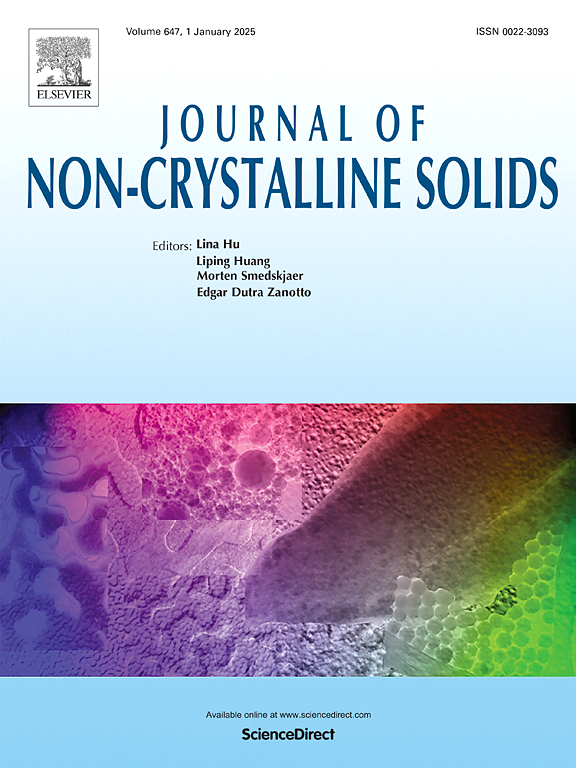Ultra-broadband near-infrared emission of AlNbO4:Cr3+ transparent glass-ceramics
IF 3.5
3区 材料科学
Q1 MATERIALS SCIENCE, CERAMICS
引用次数: 0
Abstract
Broadband near-infrared (NIR) light has wide applications in the fields of deep-tissue imaging, photodynamic therapy and industrial inspection. NIR pc-LED is regarded as a promising solution for high-performance NIR light sources due to its spectral tunability and compact design. However, the low absorption and poor chemical stability caused by a high scattering of phosphors and organic encapsulation, limit the further applications. In this study, a novel pure Cr3+-doped AlNbO4 transparent glass-ceramics (GCs) was prepared via a heat-treated (HT) technique. As the HT temperature increased from 820 °C to 900 °C, the crystallinity, crystal size and luminous intensity increase gradually, while the transmittance decrease in turn. Cr3+ preferentially substitutes for Al3+ sites and occupies octahedral coordination centers in AlNbO4 phase. The GC exhibits a high transmittance over 60 % and a high absorptivity of 80.1 % at a HT temperature of 900 °C. An ultra-broadband NIR emission (650-1400 nm) was obtained with a peak wavelength of 870 nm and a full width at half maximum (FWHM) of 237 nm under excitation at 442 nm. The GCs show an intermediate crystal field environment (Dq/B ≈ 2.3), which indicates an intermediate electron-phonon coupling and leads to a broadband NIR light. The GCs show an external quantum efficiency (EQE) of 17.7 % and a thermal-quenching resistance of 55.7 % initial intensity at 348 K. The optimized NIR LED device fabricated with AlNbO4:Cr3+ GC demonstrates a significant application potential in the fields of non-destructive security inspection and biomedical imaging.
AlNbO4:Cr3+透明微晶玻璃的超宽带近红外发射特性
宽带近红外光在深部组织成像、光动力治疗和工业检测等领域有着广泛的应用。近红外pc-LED由于其光谱可调性和紧凑的设计,被认为是高性能近红外光源的一个有前途的解决方案。然而,由于荧光粉的高散射和有机封装导致的吸收低和化学稳定性差,限制了其进一步的应用。在这项研究中,通过热处理(HT)技术制备了一种新的纯Cr3+掺杂AlNbO4透明玻璃陶瓷(GCs)。随着高温温度从820℃升高到900℃,结晶度、晶体尺寸和发光强度逐渐增大,而透过率依次降低。在AlNbO4相中,Cr3+优先取代Al3+,占据八面体配位中心。在900℃高温下,GC具有60%以上的高透射率和80.1%的高吸收率。在442 nm激发下,获得了峰值波长为870 nm、半峰全宽为237 nm的超宽带近红外发射(650 ~ 1400 nm)。GCs表现出中间的晶体场环境(Dq/B≈2.3),这表明中间的电子-声子耦合导致了宽带近红外光。在348 K时,GCs的外量子效率(EQE)为17.7%,热猝灭电阻为55.7%。优化后的AlNbO4:Cr3+ GC制备的近红外LED器件在无损安全检测和生物医学成像领域具有重要的应用潜力。
本文章由计算机程序翻译,如有差异,请以英文原文为准。
求助全文
约1分钟内获得全文
求助全文
来源期刊

Journal of Non-crystalline Solids
工程技术-材料科学:硅酸盐
CiteScore
6.50
自引率
11.40%
发文量
576
审稿时长
35 days
期刊介绍:
The Journal of Non-Crystalline Solids publishes review articles, research papers, and Letters to the Editor on amorphous and glassy materials, including inorganic, organic, polymeric, hybrid and metallic systems. Papers on partially glassy materials, such as glass-ceramics and glass-matrix composites, and papers involving the liquid state are also included in so far as the properties of the liquid are relevant for the formation of the solid.
In all cases the papers must demonstrate both novelty and importance to the field, by way of significant advances in understanding or application of non-crystalline solids; in the case of Letters, a compelling case must also be made for expedited handling.
 求助内容:
求助内容: 应助结果提醒方式:
应助结果提醒方式:


